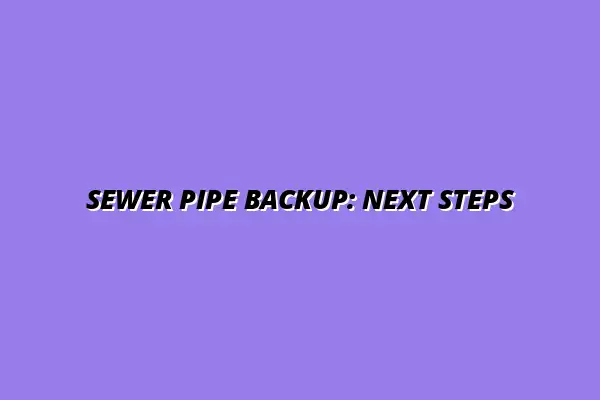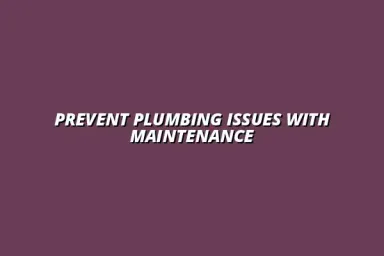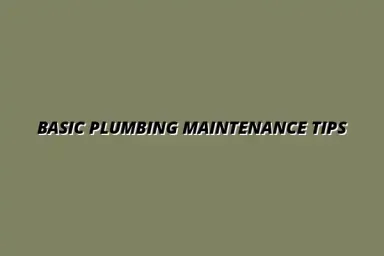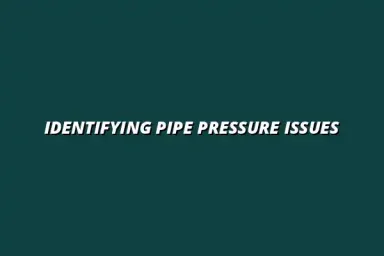Understanding Sewer Pipe Backups: Causes and Impacts
Sewer pipe backups can cause significant issues for homeowners, leading to inconvenience and possible damage to property. Understanding the factors that contribute to these backups is crucial for prevention and effective management. Let's explore the common causes and impacts of sewer pipe backups, as well as how to recognize their symptoms and what actions to take when faced with this problem.
Identifying the Common Causes of Sewer Pipe Backups
Recognizing the causes of sewer pipe backups is the first step in tackling the problem. There are several common issues that can lead to backups, and being aware of these can help you take preventive measures. Here are some of the most prevalent causes:
- Clogged drains: Accumulation of debris and foreign objects
- Tree root intrusion: The impact of roots on pipes
- Pipe damage: Signs of wear and tear
Clogged Drains: The Role of Debris and Foreign Objects
One of the primary causes of sewer pipe backups is clogged drains. Items like hair, grease, soap residue, and foreign objects can build up over time, leading to blockages. These clogs can create pressure in the system, which may eventually result in a backup. For example, a clogged kitchen sink can be a major contributor. Learning how to fix a clogged kitchen sink is a valuable skill for every homeowner.
Regular maintenance is key to preventing these clogs. You can do simple things like:
- Using drain screens to catch debris
- Avoiding flushing non-biodegradable items
- Periodically cleaning drains with vinegar and baking soda
Tree Roots Intrusion: How Plants Can Compromise Pipes
Another significant cause of sewer pipe backups stems from tree root intrusion. Roots can penetrate pipes through small cracks or joints, causing blockages and damage. These invasive roots can grow inside the pipe, leading to serious issues if left untreated.
To mitigate tree root issues, consider these tips:
- Planting trees away from sewer lines
- Using root barriers to protect pipes
- Regularly inspecting your sewer lines for potential root growth
Pipe Damage: Recognizing Signs of Wear and Tear
Over time, sewer pipes can suffer from wear and tear, leading to cracks, breaks, or misalignments. These issues can cause backups if not addressed promptly. Understanding the importance of maintaining your plumbing can help prevent many costly repairs down the line. It's essential to be aware of the signs of pipe damage, such as:
- Frequent backups or slow drainage
- Visible cracks or leaks around the pipes
- Unusual noises from the plumbing system
Recognizing the Symptoms of a Sewage Backup
Identifying the symptoms of a sewage backup can help you react swiftly to prevent further damage. The sooner you recognize the signs, the better you can manage the situation. Here are some common symptoms to watch for:
- Unpleasant odors: Foul smells indicating a problem
- Multiple clogged fixtures: Signs of a larger issue
- Backflow: A clear red flag to address
Unpleasant Odors: When to Worry About Foul Smells
Foul odors emanating from drains can be an early warning sign of a backup. If you notice persistent bad smells, it's crucial to investigate. The odor may indicate stagnant sewage sitting in the pipes, which is not only unpleasant but also a health hazard.
Make sure to check all plumbing fixtures in your home, as the smell may come from a specific location, indicating where the problem lies. Prompt action can prevent the issue from worsening!
Multiple Clogged Fixtures: Indicators of a Larger Issue
If you experience multiple clogged fixtures in your home, it's a significant indicator of a larger problem within your sewer system. This could mean that a primary line is blocked, creating a backup risk for all connected fixtures. Slow draining pipes, for instance, are often a sign of a larger problem. Check out these helpful tips on fixing slow draining bathroom pipes.
To address this, it's wise to avoid using any plumbing fixtures until the issue is resolved. This will help prevent further complications and damage.
Backflow and Slow Drainage: The Red Flags to Watch For
Backflow, or sewage flowing back into your home, is a serious problem that must be addressed immediately. If you notice slow drainage in your sinks or bathtubs, it could signal an impending backup. Learning to recognize the signs of clogged kitchen drains can help prevent larger issues. These red flags should never be ignored!
Taking quick action can save you from costly repairs and health risks due to sewage exposure. If you encounter these issues, consider calling a plumbing professional for assistance.
Immediate Actions to Take When You Encounter a Backup
When a sewer pipe backup occurs, knowing the right steps to take can make a significant difference. Here are some immediate actions you can follow to manage the situation effectively:
- Shutting off water supply: Prevent further damage
- Avoiding DIY solutions: Risks of unqualified repairs
- Documenting the problem: Importance of evidence for professionals
Shutting Off Water Supply: Preventing Further Damage
The first thing to do when you notice a backup is to shut off your water supply. This prevents additional water from entering the system, which can worsen the situation. Locate your main water shut-off valve and turn it off.
This simple step can save you from more severe damage and costly repairs in the long run. Take your time to ensure that all water sources are turned off!
Avoiding DIY Solutions: The Risks of Unqualified Repairs
While it may be tempting to try a DIY fix for a sewer backup, this can often lead to more harm than good. Without the proper expertise, you could make the situation worse or even endanger your health. If you are experiencing a plumbing emergency in Billesley, Birmingham, consider contacting a local plumber. It's essential to know your limits and when to call in a professional.
Professionals have the right tools and training to handle these emergencies safely and effectively. Don't hesitate to reach out for help!
Documenting the Problem: Importance of Evidence for Professionals
Taking photographs and keeping records of the backup can be crucial for any insurance claims or professional assessments. Documenting the issue helps professionals understand the severity and scope of the problem. This evidence can also assist in ensuring you receive the appropriate help and compensation.
Make sure to keep a log of events, including dates, times, and any actions taken, as this information can be very helpful down the line.
Long-Term Solutions and Considerations for Sewer Pipe Health
Taking care of your sewer pipes is essential for maintaining a healthy home environment. With the right approach, you can prevent backups and costly repairs down the line. In this section, we'll explore long-term solutions to ensure your sewer system remains in optimal condition.
If you're facing recurring issues, it might be time to consider upgrading your sewer pipes. Maintaining a healthy bathroom sewer line is a key part of preventing future problems. Learn more about maintaining your bathroom sewer line to avoid costly repairs. Doing so can enhance efficiency and longevity. Let's look at some effective options available to homeowners.
Pipe Replacement Options: When It’s Time to Upgrade
Sometimes, old sewer pipes just can't keep up with the demands of modern plumbing. If you notice persistent issues, you may need to look into pipe replacement. There are several choices available that can be beneficial for your plumbing system.
Here are some common pipe materials that you can consider:
- PVC (Polyvinyl Chloride): Lightweight and resistant to corrosion.
- ABS (Acrylonitrile Butadiene Styrene): Tough and durable, ideal for underground installations.
- Cast Iron: Long-lasting but heavier and can be costly to install.
- HDPE (High-Density Polyethylene): Flexible and resistant to cracking.
Each material has its pros and cons, so it's important to consult with a professional to find the best fit for your needs.
Understanding Modern Pipe Materials and Their Benefits
The choice of pipe material can significantly impact the lifetime of your sewer system. Modern materials offer improved resistance to wear and environmental factors. For instance, PVC pipes are lightweight and easy to install, while HDPE pipes are known for their flexibility, making them suitable for various terrains.
In addition to durability, modern materials can provide better flow rates and lower chances of clogs. Investing in high-quality materials can save you money on repairs and maintenance in the long run.
Cost Considerations for Pipe Replacement Projects
When considering pipe replacement, the cost is a major factor. Several elements can influence the overall expense:
- Material Cost: Prices vary widely depending on the type of pipe.
- Labor Costs: Professional installation can add to your budget.
- Extent of Damage: The more extensive the damage, the higher the repair costs.
- Permits and Inspections: These can also contribute to your total investment.
It's wise to get multiple quotes from different plumbing professionals to ensure you're getting a fair price.
Understanding Insurance Coverage for Sewer Issues
As a homeowner, it’s crucial to know how your insurance policy covers sewer-related problems. Understanding your homeowners insurance can save you from unexpected expenses if a backup occurs. Knowing what your policy covers is important, especially when dealing with unexpected issues such as those related to water heaters. Not all policies cover sewage backups, so it's essential to review your options.
Let’s explore some key aspects of insurance coverage for sewer issues.
Reviewing Your Homeowners Insurance Policy for Sewer Backup Coverage
Many homeowners overlook the specifics of their insurance policy, especially when it comes to sewer backups. It’s important to check whether your policy includes coverage for:
- Sewer Backup: This specific coverage protects against damage caused by backups.
- Personal Property Damage: Ensures that your belongings are covered in case of damage.
- Cleanup & Restoration Costs: Covers expenses related to cleaning up after a backup.
If you find your policy lacking, consider discussing additional coverage options with your insurance agent.
How to File a Claim for Sewer Backup Damage
Filing an insurance claim can be a daunting task, but knowing the steps can ease the process. If you experience a sewer backup, here’s how to approach filing a claim:
- Document the Damage: Take photos and make a list of affected areas and belongings.
- Contact Your Insurer: Notify them about the incident as soon as possible.
- Complete the Claim Form: Fill out the necessary paperwork provided by your insurance company.
- Follow Up: Stay in communication with your insurer to ensure timely processing.
Being organized and prompt can help speed up your claim and potentially recover your losses.
Seeking Assistance: Support Resources for Homeowners
If sewer issues arise, knowing where to seek help is essential. Various resources can support homeowners in managing these challenges effectively. Let’s look at the options available.
Finding professional help is crucial if you encounter persistent sewer problems. You can access resources like:
Finding Local Plumbing Resources and Emergency Services
Searching for reliable plumbing services can be overwhelming. Here are some tips on how to find local plumbing experts:
- Ask for Recommendations: Talk to neighbors or friends for trusted plumber referrals.
- Check Online Reviews: Websites like Yelp and Angie's List can provide valuable feedback.
- Verify Credentials: Ensure that the plumber is licensed and insured.
Getting the right help can make all the difference when dealing with sewer pipe issues.
Community Programs for Sewer Maintenance Education
Many communities offer programs that educate homeowners about sewer maintenance. Participating in these initiatives can help you stay informed about best practices. Look for:
- Workshops: Local municipalities often host informational workshops.
- Online Resources: Check your local government’s website for helpful guides.
- Home Improvement Events: Attend events to learn more about plumbing and maintenance.
These resources can empower you to take better care of your home’s sewer system.

 Kiran Almasi
Kiran Almasi

